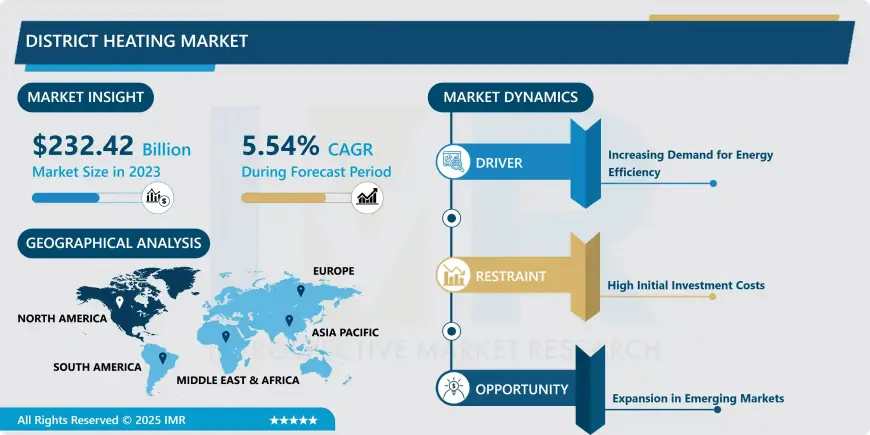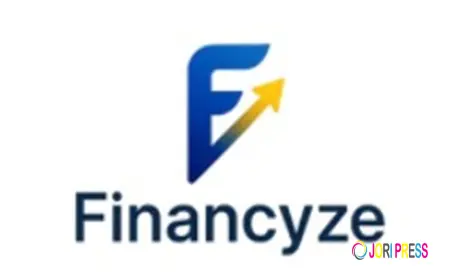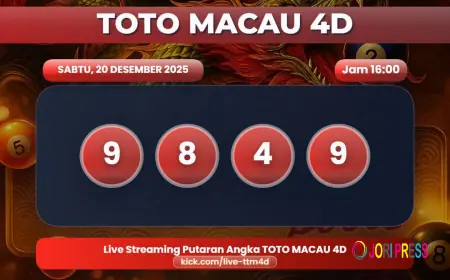District Heating Market - New Era Of Market & Forecast 2024 – 2032

District Heating Market - New Era Of Market & Forecast 2024 – 2032
District heating refers to the centralized supply of heat energy from a single source to multiple buildings within a defined area through a network of insulated pipes. This system uses various energy sources—including natural gas, coal, oil, and increasingly, renewable energy—to generate hot water or steam for heating purposes. Widely recognized as a key component of urban energy infrastructure, district heating offers efficient and often sustainable heating solutions for residential, commercial, and industrial buildings. Its growing adoption reflects the need for cleaner, more reliable energy distribution in densely populated regions.
District Heating Market Size Was Valued at USD 232.42 Billion in 2023, and is Projected to Reach USD 377.60 Billion by 2032, Growing at a CAGR of 5.54% From 2024-2032.
Some of the Top Leading Key Players:
Veolia Environnement (France), Engie (France), Fortum (Finland), Vattenfall AB (Sweden), E.ON SE (Germany), Dalkia (France), RWE AG (Germany), Statkraft AS (Norway), Centrica PLC (UK), Fingrid Oyj (Finland), Other Active Player
IMR posted new studies guide on District Heating Market Insights with self-defined Tables and charts in presentable format. In the Study you may locate new evolving Trends, Drivers, Restraints, Opportunities generated via targeting market related stakeholders. The boom of the District Heating marketplace became specifically driven with the aid of the growing R&D spending internationally.
Download Sample Report PDF (Including Full TOC, Table & Figures) @
https://introspectivemarketresearch.com/request/18014
District Heating Market Synopsis:
The District Heating marketplace studies have a look at ensures the highest level of accuracy and reliability as we exactly study the general industry, masking all the market fundamentals. By leveraging a wide range of number one and secondary resources, we set up a sturdy basis for our findings. Industry-widespread tools like Porter's Five Forces Analysis, SWOT Analysis, pestle Analysis and Price Trend Analysis in addition enhance the comprehensiveness of our assessment. Our examine additionally discusses the entire District Heating marketplace surroundings, explaining the various market stakeholders, their functions and interdependencies among them. Further, with an emphasis on complete segmentation evaluation and geographical coverage, the have a look at allows a profound expertise of nearby tendencies. Moreover, we discover outside factors presenting a comprehensive view of the market dynamics.
Segmentation Analysis:
District Heating Market Global Industry Analysis and Forecast (2024-2032) By Heat Source(Coal, Natural Gas, Renewable, Oil & Petroleum Products, Others) Plant Type(Boiler, CHP) Application (Residential, Commercial, Industrial), and Region
Do you have any queries or specific requirements? Ask our industry expert
https://introspectivemarketresearch.com/inquiry/18014
District Heating Market Dynamics and Factors:
The shift toward renewable energy is a major force shaping the district heating market. As the global fight against climate change intensifies, many district heating utilities are transitioning from fossil fuels to cleaner, more sustainable energy sources. This move not only aligns with global sustainability goals but also enhances supply chain resilience by reducing dependency on volatile fuel prices. By integrating renewables such as solar, wind, biomass, and geothermal energy, district heating systems can significantly lower urban carbon emissions, positioning themselves as a key solution for sustainable and resilient urban energy infrastructure.
Regional Analysis
Europe is Expected to Dominate the Market Over the Forecast period
Geographically, the distinctive analysis of consumption, revenue, market share, and growth rate of the subsequent areas:
- North America (U.S., Canada, Mexico)
- Eastern Europe (Russia, Bulgaria, The Czech Republic, Hungary, Poland, Romania, Rest of Eastern Europe)
- Western Europe (Germany, UK, France, Netherlands, Italy, Spain, Rest of Western Europe)
- Asia Pacific (China, India, Japan, South Korea, Malaysia, Thailand, Vietnam, The Philippines, Australia, New-Zealand, Rest of APAC)
- Middle East & Africa (Türkiye, Bahrain, Kuwait, Saudi Arabia, Qatar, UAE, Israel, South Africa)
- South America (Brazil, Argentina, Rest of SA)
Key Industry Developments in the District Heating Market:
In March 2024, Hitachi Energy has secured a significant contract to provide grid connection solutions in Finland for the world’s largest data center heat recovery initiative. This project involves recovering and repurposing excess heat from data centers to heat various premises belonging to Fortum, including homes, public facilities, and businesses. Fortum, a prominent Nordic energy company, has chosen Hitachi Energy to supply advanced grid connection solutions. This technology will facilitate the replacement of fossil fuels with sustainable, emission-free energy sources within Helsinki’s district heating infrastructure.
Read Detailed Index of full Research Study:
https://introspectivemarketresearch.com/reports/district-heating-market/
Study Objectives of this report are:
- To study and analyze the global District Heating market size (value and volume) by company, key regions/countries, products and application, history data from 2017 to 2023, and forecast to 2032.
- To understand the structure of District Heating market by identifying its various subsegments.
- To share detailed information about the key factors influencing the growth of the market
- Focuses on the key global District Heating manufacturers, to define, describe and analyze the sales volume, value, market share, market competition landscape, SWOT analysis and development plans in next few years.
- To analyze the District Heating with respect to individual growth trends, future prospects, and their contribution to the total market.
- To project the value and volume of District Heating submarkets, with respect to key regions (along with their respective key countries).
- To analyze competitive developments such as expansions, agreements, new product launches, and acquisitions in the market.
- To strategically profile the key players and comprehensively analyze their growth strategies.
Introspective Market Research is a trusted partner for comprehensive market research studies. We are committed to providing businesses worldwide with comprehensive market research studies that offer valuable insights and strategic guidance
With a precise examination of the overall industry, our District Heating market report guarantees the highest level of accuracy and reliability. We establish a strong foundation for our findings by leveraging a wide range of primary and secondary sources. Enhancing the comprehensiveness of our evaluation, we utilize industry-standard tools such as Porter's Five Forces Analysis, SWOT Analysis, and Price Trend Analysis.
Key Questions Answered In The Report
- How much is the District Heating Market worth?
- At what CAGR is the market projected to grow over the estimated period?
- What factors contribute to the growth of the industry?
- Which region is anticipated to hold the largest share of the market?
- Which industry segment is projected to witness the fastest market growth?
- What are the key opportunities and trends industry participants might encounter?
Buy Now and Gain Access to the Market Report @
https://introspectivemarketresearch.com/checkout/?user=1&_sid=18014
About us:
At Introspective Market Research Private Limited, we are a forward-thinking research consulting firm committed to driving our clients' growth and market dominance. Leveraging cutting-edge technology, big data, and advanced analytics, we provide deep insights and strategic solutions that enable our clients to stay ahead in a competitive landscape. Our expertise spans across comprehensive Market Research Reports, Holistic Market Insights, Macro-Economic Analysis, and tailored Go-to-Market (GTM) Strategies. Through our Consulting Services and AI-Driven Solutions, we empower businesses to navigate challenges and achieve their objectives. Additionally, we offer Product Design and Prototyping support and Flexible Staffing Solutions to meet evolving industry demands. Our IMR Knowledge Cluster ensures continuous learning and innovation, guiding our clients toward sustainable success.
Contact us:
Vishwanath K (PR & Marketing Manager)
Introspective Market Research Private Limited
Phone: +91-81800-96367 / +91-7410103736
Email: [email protected]
What's Your Reaction?
 Like
0
Like
0
 Dislike
0
Dislike
0
 Love
0
Love
0
 Funny
0
Funny
0
 Angry
0
Angry
0
 Sad
0
Sad
0
 Wow
0
Wow
0




















































